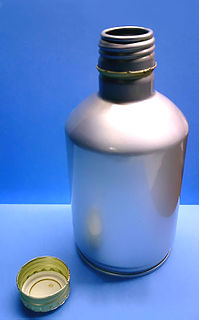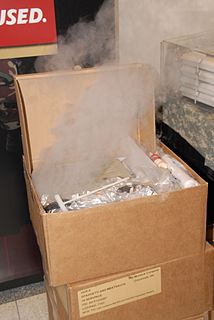
In thermodynamics, the term exothermic process describes a process or reaction that releases energy from the system to its surroundings, usually in the form of heat, but also in a form of light, electricity, or sound. Its etymology stems from the Greek prefix έξω and the Greek word θερμικός. The term exothermic was first coined by Marcellin Berthelot. The opposite of an exothermic process is an endothermic process, one that absorbs energy in the form of heat.

Sulfuric acid (alternative spelling sulphuric acid), also known as vitriol, is a mineral acid composed of the elements sulfur, oxygen and hydrogen, with molecular formula H2SO4. It is a colorless, odorless, and syrupy liquid that is soluble in water and is synthesized in reactions that are highly exothermic.

Brine is a high-concentration solution of salt in water. In different contexts, brine may refer to salt solutions ranging from about 3.5% up to about 26%. Lower levels of concentration are called by different names: fresh water, brackish water, and saline water.

A flameless ration heater, or FRH, is a water-activated exothermic chemical heater included with meals, ready-to-eat (MREs), used to heat the food. US military specifications for the heater require it be capable of raising the temperature of an 8-ounce (226.8 g) entree by 100 °F (38 °C) in twelve minutes, and that it has no visible flame.

A lye is a metal hydroxide traditionally obtained by leaching ashes, or a strong alkali which is highly soluble in water producing caustic basic solutions. "Lye" is commonly an alternative name of sodium hydroxide (NaOH) or historically potassium hydroxide (KOH), though the term "lye" refers most commonly to sodium hydroxide.

Calcium hydroxide (traditionally called slaked lime) is an inorganic compound with the chemical formula Ca(OH)2. It is a colorless crystal or white powder and is produced when quicklime (calcium oxide) is mixed, or slaked with water. It has many names including hydrated lime, caustic lime, builders' lime, slack lime, cal, or pickling lime. Calcium hydroxide is used in many applications, including food preparation, where it has been identified as E number E526. Limewater is the common name for a saturated solution of calcium hydroxide.

A reusable bottle is a bottle that can be reused, as in the case as by the original bottler or by end-use consumers. Reusable bottles have grown in popularity by consumers for both environmental and health safety reasons. Reusable bottles are one example of reusable packaging.

Calcium sulfate (or calcium sulphate) is the inorganic compound with the formula CaSO4 and related hydrates. In the form of γ-anhydrite (the anhydrous form), it is used as a desiccant. One particular hydrate is better known as plaster of Paris, and another occurs naturally as the mineral gypsum. It has many uses in industry. All forms are white solids that are poorly soluble in water. Calcium sulfate causes permanent hardness in water.
The heating value of a substance, usually a fuel or food, is the amount of heat released during the combustion of a specified amount of it.

Closures are devices and techniques used to close or seal container such as a bottle, jug, jar, tube, can, etc. Closures can be a cap, cover, lid, plug, etc.
A heating pad is a pad used for warming of parts of the body in order to manage pain. Localized application of heat causes the blood vessels in that area to dilate, enhancing perfusion to the targeted tissue. Types of heating pads include electrical, chemical and hot water bottles.

Carbide lamps, or acetylene gas lamps, are simple lamps that produce and burn acetylene (C2H2) which is created by the reaction of calcium carbide (CaC2) with water (H2O).
Thermal decomposition, or thermolysis, is a chemical decomposition caused by heat. The decomposition temperature of a substance is the temperature at which the substance chemically decomposes. The reaction is usually endothermic as heat is required to break chemical bonds in the compound undergoing decomposition. If decomposition is sufficiently exothermic, a positive feedback loop is created producing thermal runaway and possibly an explosion.

Induction sealing is the process of bonding thermoplastic materials by induction heating. This involves controlled heating an electrically conducting object by electromagnetic induction, through heat generated in the object by eddy currents.

Self-heating food packaging (SHFP) is active packaging with the ability to heat food contents without external heat sources or power. Packets typically use an exothermic chemical reaction. Packets can also be self-cooling. These packages are useful for military operations, during natural disasters, or whenever conventional cooking is not available. These packages are often used to prepare main courses such as meat dishes, which are more palatable when hot.
The terms active packaging, intelligent packaging, and smart packaging refer to packaging systems used with foods, pharmaceuticals, and several other types of products. They help extend shelf life, monitor freshness, display information on quality, improve safety, and improve convenience.
Nanoreactors are a form of chemical reactor that are particularly in the disciplines of nanotechnology and nanobiotechnology. These special reactors are crucial in maintaining a working nanofoundry; which is essentially a foundry that manufactures products on a nanotechnological scale.















